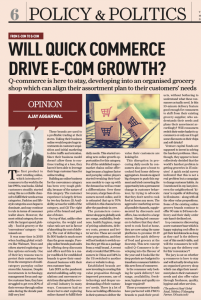
Two weeks ago, a friend of mine in the consulting business invited me to attend an event on customer experience. His company was presenting its new set of framework, CINDEXDS and CINDEXBQ – which basically quantify the level of delight customers feel for a particular brand and also measures a bottom quartile score that indicates the number of customers ready to switch brands in favour of the competition.
Their basic premise is 71% of customers switch brand just because of unsatisfactory experience and only 45% due to price. Because customer expectations are changing or rather upgrading continuously, 2 out of every 3 customers shift from one brand to another every year. This finding is consistent across different categories of products or services.
Through continuous surveys, the tool benchmarks the response of customers on five key parameters — overall satisfaction, meeting customer’s expectations, delivering value for money, loyalty with the brand and advocacy of the brand. The idea is to benchmark these scores against the brand promise.
The first question asked to each customer is “Can you share the best shopping or service experience you had recently” and interestingly most can’t recall any! However, most are very forthcoming with incidents which could have been much better and memorable.
It turns out that the key differentiators for customer experience across airlines, banks, credit cards, mobile service providers and retail departmental stores are the same: the people and the processes. After all, airlines use similar aircraft, banks and credit cards have similar products/services, and departmental stores offer almost the same brands to their customers.
Today, the most popular airlines across the world are known for the interaction of their employees. In fact, according to a CINDEX analysis on mobile service providers in India, the service of the best brands in the country is differentiated only by the quality of human interaction with the customers. Interestingly, this has shown different results in different parts of the country. That means the quality of people employed by them in each zone is different and that is making a direct impact on the service levels of the brand. And this difference in service levels is easy for most of us to identify.
Like last week while celebrating my birthday, my wife decided to take all of us out for shopping at the mall in Amanora Town Centre. This place hosts almost every brand in the lifestyle category and as we were short of time, we decided to shop at one of the leading departmental stores instead of visiting multiple brand stores. The children picked up few garments and we approached the cash tills to pay. However, as is unfortunately turning out to be the norm in most stores, only one till was working. After standing in line for more than 10 minutes, we didn’t want to wait any longer and decided to drop our shopping and leave! The project failed and we were disappointed.
On leaving the store, we wondered why any retailer would set up such a big store with such a wide range of merchandise on display but then not make the provision to actually sell those to the visiting customers! We wondered what made it so unfriendly – the culture of the store or skills and motivation of the people running the store?
There was one more stop we made that evening, to the store of a high-street multinational brand. And this experience was completely different. We were treated with courtesy, the store attendants were smiling and helpful and we actually felt like shopping!
When we compared the two drastically different shopping experiences, we found that the staff in both stores seemed to be from similar socio-economic backgrounds. So, what made the two experiences that different? It could have been the training process, the salary, the pride which the staff felt in being associated with an important international brand, or the in-store culture.
Perhaps, developing such a high level of customer experience is a combination of all these aspects. And if examined more closely, the procedures required to enable memorable shopping experiences aren’t that difficult – they’re mostly common sense!
From a series of articles commissioned by DNA (Money) dated 19 September 2012.



